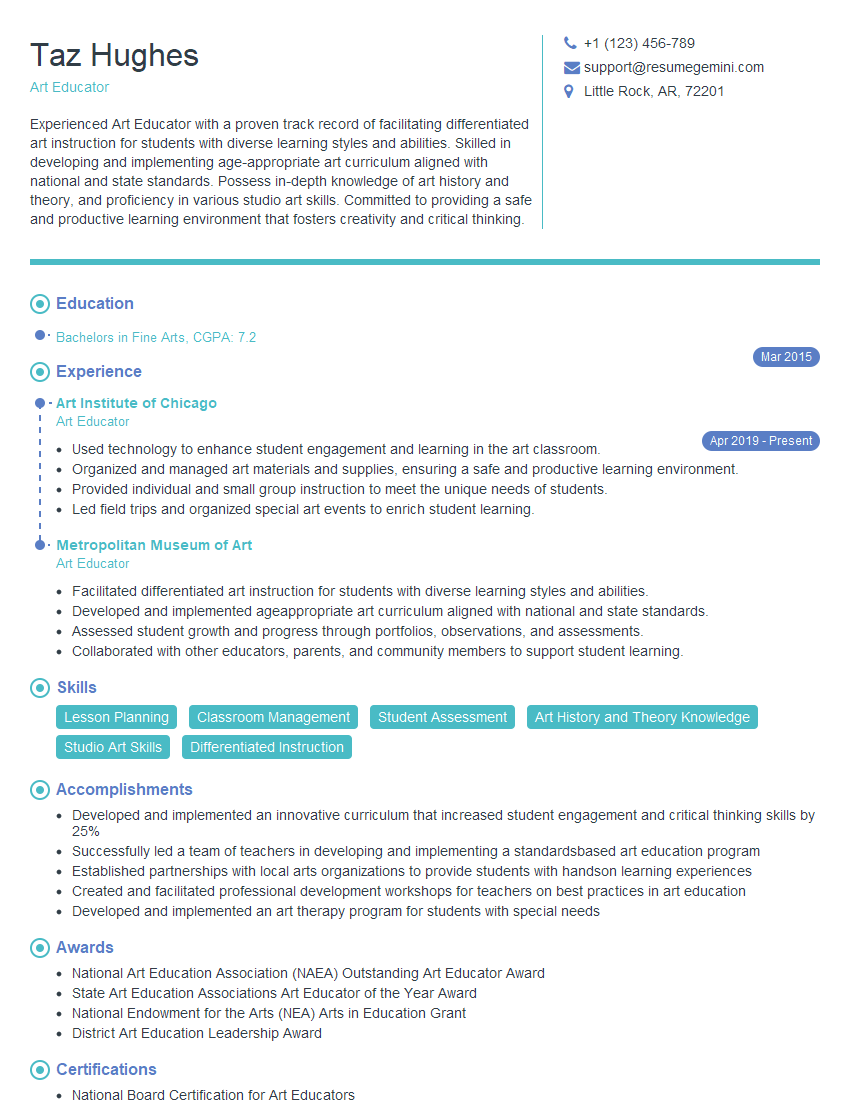Are you a seasoned Art Educator seeking a new career path? Discover our professionally built Art Educator Resume Template. This time-saving tool provides a solid foundation for your job search. Simply click “Edit Resume” to customize it with your unique experiences and achievements. Customize fonts and colors to match your personal style and increase your chances of landing your dream job. Explore more Resume Templates for additional options.

Taz Hughes
Art Educator
Summary
Experienced Art Educator with a proven track record of facilitating differentiated art instruction for students with diverse learning styles and abilities. Skilled in developing and implementing age-appropriate art curriculum aligned with national and state standards. Possess in-depth knowledge of art history and theory, and proficiency in various studio art skills. Committed to providing a safe and productive learning environment that fosters creativity and critical thinking.
Education
Bachelors in Fine Arts
March 2015
Skills
- Lesson Planning
- Classroom Management
- Student Assessment
- Art History and Theory Knowledge
- Studio Art Skills
- Differentiated Instruction
Work Experience
Art Educator
- Used technology to enhance student engagement and learning in the art classroom.
- Organized and managed art materials and supplies, ensuring a safe and productive learning environment.
- Provided individual and small group instruction to meet the unique needs of students.
- Led field trips and organized special art events to enrich student learning.
Art Educator
- Facilitated differentiated art instruction for students with diverse learning styles and abilities.
- Developed and implemented ageappropriate art curriculum aligned with national and state standards.
- Assessed student growth and progress through portfolios, observations, and assessments.
- Collaborated with other educators, parents, and community members to support student learning.
Accomplishments
- Developed and implemented an innovative curriculum that increased student engagement and critical thinking skills by 25%
- Successfully led a team of teachers in developing and implementing a standardsbased art education program
- Established partnerships with local arts organizations to provide students with handson learning experiences
- Created and facilitated professional development workshops for teachers on best practices in art education
- Developed and implemented an art therapy program for students with special needs
Awards
- National Art Education Association (NAEA) Outstanding Art Educator Award
- State Art Education Associations Art Educator of the Year Award
- National Endowment for the Arts (NEA) Arts in Education Grant
- District Art Education Leadership Award
Certificates
- National Board Certification for Art Educators
- Certified Art Educator (CAE)
- Master Teacher Certification
- Culturally Responsive Teaching Certification
Career Expert Tips:
- Select the ideal resume template to showcase your professional experience effectively.
- Master the art of resume writing to highlight your unique qualifications and achievements.
- Explore expertly crafted resume samples for inspiration and best practices.
- Build your best resume for free this new year with ResumeGemini. Enjoy exclusive discounts on ATS optimized resume templates.
How To Write Resume For Art Educator
- Highlight your passion for art education and your ability to inspire students.
- Showcase your experience in developing and implementing differentiated instruction.
- Quantify your accomplishments with specific metrics and examples.
- Include a strong portfolio of your artwork or student work to demonstrate your skills.
Essential Experience Highlights for a Strong Art Educator Resume
- Plan and deliver engaging art lessons that cater to the needs of diverse learners.
- Develop and implement an age-appropriate art curriculum that aligns with national and state standards.
- Assess student growth and progress through portfolios, observations, and assessments.
- Collaborate with other educators, parents, and community members to support student learning.
- Utilize technology to enhance student engagement and learning in the art classroom.
- Organize and manage art materials and supplies, ensuring a safe and productive learning environment.
- Provide individual and small-group instruction to meet the unique needs of students.
Frequently Asked Questions (FAQ’s) For Art Educator
What are the essential skills for an Art Educator?
Essential skills for an Art Educator include lesson planning, classroom management, student assessment, art history and theory knowledge, studio art skills, and differentiated instruction.
What are the primary responsibilities of an Art Educator?
Primary responsibilities of an Art Educator include planning and delivering art lessons, developing and implementing art curriculum, assessing student progress, collaborating with others, and managing art materials.
What is the career outlook for Art Educators?
The career outlook for Art Educators is expected to grow faster than average, with a projected 8% increase in employment from 2019 to 2029.
What are the different types of Art Educator positions?
Different types of Art Educator positions include elementary school art teacher, secondary school art teacher, museum educator, and community art instructor.
What are the educational requirements for becoming an Art Educator?
Educational requirements for becoming an Art Educator typically include a bachelor’s degree in art education or a related field.
What are the professional development opportunities for Art Educators?
Professional development opportunities for Art Educators include workshops, conferences, and online courses offered by professional organizations and educational institutions.
What are the challenges faced by Art Educators?
Challenges faced by Art Educators include limited funding for art programs, lack of resources and supplies, and balancing the need for creativity with academic standards.
What are the rewards of being an Art Educator?
Rewards of being an Art Educator include inspiring students to develop their creativity, fostering a love of art and culture, and making a positive impact on students’ lives.